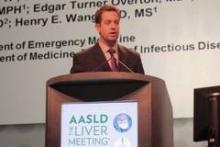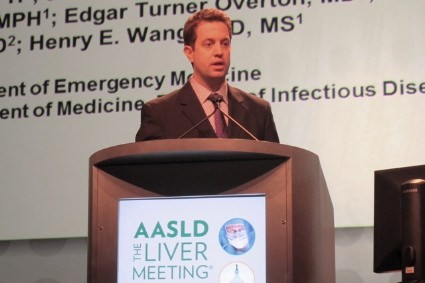User login
WASHINGTON – A pilot study screening for hepatitis C in the emergency department found that at least 12% of baby boomers who were previously unaware of their HCV status were positive for the virus.
Infection was confirmed in almost 9% of HCV-positive patients, lead author Dr. James W. Galbraith reported at the annual meeting of the American Association for the Study of Liver Diseases.
Dr. Galbraith, an associate professor of emergency medicine at the University of Alabama, Birmingham, reported on initial results of a screening program funded by the Centers for Disease Control and Prevention that began in September. Results are currently tabulated through Oct. 17. During that time, there were 2,363 unique ED visits by patients born in the years 1945 to 1965. Seventy-three percent (1,721) agreed to answer two questions given by a triage nurse: Have you ever been tested for HCV, and if yes, are you aware of that result? Seventy-five percent, or 1,287 patients, did not know their status and were offered testing.
Of those, 90% (1,148) accepted the antibody test. Patients were excluded from testing if they were medically or surgically unstable, had known HCV infection, or if they chose to opt out.
Antibody tests were performed on 984 of those patients, with results returned to ED physicians within 30-60 minutes. Eighty-eight percent had negative results, but 12%, or 118 patients, were HCV positive.
Researchers attempt to verify positive test results with polymerase chain reaction testing, but it is not always easy to do so, said Dr. Galbraith. Patients must be kept for a new blood draw, and many have already left the ED. Testing is also expensive, he noted.
Overall, men were significantly more likely than were women to test positive (17% compared with 8%). There was no significant difference in HCV positivity rates between whites and African Americans (11% vs. 13%). Patients without insurance or those on Medicaid or other public insurance plans were significantly more likely to be positive, with 17% in each of those groups exhibiting reactivity on the antibody assay, compared with 5% of insured patients.
When patients are determined to be HCV positive, ED physicians counsel and direct them to resources in the community, including specialists. Dr. Galbraith said that the numbers of baby boomers being found to be HCV positive are likely to overwhelm the available specialists.
By September 2014, Dr. Galbraith said, his ED is likely to screen 8,000 baby boomers. If the prevalence rate remains stable, that would mean 864 who are HCV positive and more than 600 with confirmed infection, he said.
Still, it’s important to screen, said Dr. Galbraith, adding that given the study results, "the implication is that the ED may be an important venue for HCV screening."
Two federal entities have called for increased screening. In May, the CDC urged HCV testing for all Americans born between 1945 and 1965.
The U.S. Preventive Services Task Force followed in June, recommending routine HCV screening for high risk Americans, and one-time screening for adults born between 1945 and 1965.
The study was funded by the Centers for Disease Control and Prevention. Dr. Galbraith reported no disclosures.
On Twitter @aliciaault
WASHINGTON – A pilot study screening for hepatitis C in the emergency department found that at least 12% of baby boomers who were previously unaware of their HCV status were positive for the virus.
Infection was confirmed in almost 9% of HCV-positive patients, lead author Dr. James W. Galbraith reported at the annual meeting of the American Association for the Study of Liver Diseases.
Dr. Galbraith, an associate professor of emergency medicine at the University of Alabama, Birmingham, reported on initial results of a screening program funded by the Centers for Disease Control and Prevention that began in September. Results are currently tabulated through Oct. 17. During that time, there were 2,363 unique ED visits by patients born in the years 1945 to 1965. Seventy-three percent (1,721) agreed to answer two questions given by a triage nurse: Have you ever been tested for HCV, and if yes, are you aware of that result? Seventy-five percent, or 1,287 patients, did not know their status and were offered testing.
Of those, 90% (1,148) accepted the antibody test. Patients were excluded from testing if they were medically or surgically unstable, had known HCV infection, or if they chose to opt out.
Antibody tests were performed on 984 of those patients, with results returned to ED physicians within 30-60 minutes. Eighty-eight percent had negative results, but 12%, or 118 patients, were HCV positive.
Researchers attempt to verify positive test results with polymerase chain reaction testing, but it is not always easy to do so, said Dr. Galbraith. Patients must be kept for a new blood draw, and many have already left the ED. Testing is also expensive, he noted.
Overall, men were significantly more likely than were women to test positive (17% compared with 8%). There was no significant difference in HCV positivity rates between whites and African Americans (11% vs. 13%). Patients without insurance or those on Medicaid or other public insurance plans were significantly more likely to be positive, with 17% in each of those groups exhibiting reactivity on the antibody assay, compared with 5% of insured patients.
When patients are determined to be HCV positive, ED physicians counsel and direct them to resources in the community, including specialists. Dr. Galbraith said that the numbers of baby boomers being found to be HCV positive are likely to overwhelm the available specialists.
By September 2014, Dr. Galbraith said, his ED is likely to screen 8,000 baby boomers. If the prevalence rate remains stable, that would mean 864 who are HCV positive and more than 600 with confirmed infection, he said.
Still, it’s important to screen, said Dr. Galbraith, adding that given the study results, "the implication is that the ED may be an important venue for HCV screening."
Two federal entities have called for increased screening. In May, the CDC urged HCV testing for all Americans born between 1945 and 1965.
The U.S. Preventive Services Task Force followed in June, recommending routine HCV screening for high risk Americans, and one-time screening for adults born between 1945 and 1965.
The study was funded by the Centers for Disease Control and Prevention. Dr. Galbraith reported no disclosures.
On Twitter @aliciaault
WASHINGTON – A pilot study screening for hepatitis C in the emergency department found that at least 12% of baby boomers who were previously unaware of their HCV status were positive for the virus.
Infection was confirmed in almost 9% of HCV-positive patients, lead author Dr. James W. Galbraith reported at the annual meeting of the American Association for the Study of Liver Diseases.
Dr. Galbraith, an associate professor of emergency medicine at the University of Alabama, Birmingham, reported on initial results of a screening program funded by the Centers for Disease Control and Prevention that began in September. Results are currently tabulated through Oct. 17. During that time, there were 2,363 unique ED visits by patients born in the years 1945 to 1965. Seventy-three percent (1,721) agreed to answer two questions given by a triage nurse: Have you ever been tested for HCV, and if yes, are you aware of that result? Seventy-five percent, or 1,287 patients, did not know their status and were offered testing.
Of those, 90% (1,148) accepted the antibody test. Patients were excluded from testing if they were medically or surgically unstable, had known HCV infection, or if they chose to opt out.
Antibody tests were performed on 984 of those patients, with results returned to ED physicians within 30-60 minutes. Eighty-eight percent had negative results, but 12%, or 118 patients, were HCV positive.
Researchers attempt to verify positive test results with polymerase chain reaction testing, but it is not always easy to do so, said Dr. Galbraith. Patients must be kept for a new blood draw, and many have already left the ED. Testing is also expensive, he noted.
Overall, men were significantly more likely than were women to test positive (17% compared with 8%). There was no significant difference in HCV positivity rates between whites and African Americans (11% vs. 13%). Patients without insurance or those on Medicaid or other public insurance plans were significantly more likely to be positive, with 17% in each of those groups exhibiting reactivity on the antibody assay, compared with 5% of insured patients.
When patients are determined to be HCV positive, ED physicians counsel and direct them to resources in the community, including specialists. Dr. Galbraith said that the numbers of baby boomers being found to be HCV positive are likely to overwhelm the available specialists.
By September 2014, Dr. Galbraith said, his ED is likely to screen 8,000 baby boomers. If the prevalence rate remains stable, that would mean 864 who are HCV positive and more than 600 with confirmed infection, he said.
Still, it’s important to screen, said Dr. Galbraith, adding that given the study results, "the implication is that the ED may be an important venue for HCV screening."
Two federal entities have called for increased screening. In May, the CDC urged HCV testing for all Americans born between 1945 and 1965.
The U.S. Preventive Services Task Force followed in June, recommending routine HCV screening for high risk Americans, and one-time screening for adults born between 1945 and 1965.
The study was funded by the Centers for Disease Control and Prevention. Dr. Galbraith reported no disclosures.
On Twitter @aliciaault
AT THE LIVER MEETING 2013
Major finding: Twelve percent of baby boomers were HCV-positive, and 8.7% had confirmed infection in an emergency department screening study.
Data source: Six-week results of screening of 1,721 patients born between 1945 and 1965.
Disclosures: The study was funded by the Centers for Disease Control and Prevention. Dr. Galbraith reported no disclosures.

